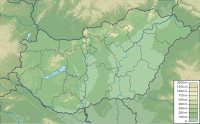 | ||
| Dunaújváros | ||
| County | Fejér | |
|---|---|---|
| Residents | 44.200 (2019) | |
| height | 116 m | |
| no tourist info on Wikidata: | ||
| location | ||
| ||
Dunaújváros is an industrial city in the county Fejér on the right bank of the Danube. After the Second World War, a large steelworks and settlement for approx. 50,000 inhabitants were built around a small village. Thus Dunaújvaros offers a very good insight into the architecture and urban planning of the early post-war period in Eastern Europe.

background
From around 100 AD the Roman fort Intercisa was located in the urban area, which monitored the Limes. A medium-sized city quickly developed around it, but it fell into desolation after the end of the Western Roman Empire.
A new settlement is proven from the time of the Hungarian conquest in the early 10th century, an Arpad church was consecrated to Saint Pantaleon (hence the name Dunapentele - freely translated St. Pantaleon on the Danube). This place became deserted for a few years during the Ottoman occupation and was repopulated from the 17th century. The village remained a relatively insignificant village with around 3,500 inhabitants until the Second World War.
In 1949 a large steel mill was initially built by the Soviet occupiers Mohács planned, but the Central Committee of the Hungarian Communists decided to build the large ironworks combine with the associated workers' settlement in Dunapentele instead. The very first planned socialist town in Hungary was named in honor of the Soviet dictator Stalin (Sztálinváros) and after the death of Stalin and the "de-Stalinization" in 1961, which was already well advanced in the Soviet Union, it was renamed to the current name Dunaújváros (German translation: Neustadt an der Donau ).
getting there
By plane
By train
Regional trains the MÁV run every hour between the train station Budapest Déli and Dunaújváros; Driving time 1:30 h. Coming from Vienna you change at Kelenföld train station, so you save the inner-city transfer in Budapest from Keleti train station.
If you take the train out Pécs arrives, you can already in Simontornya change. In terms of schedule, however, it may be cheaper to go to Pusztaszabolcs continue to where you can catch the hourly regional trains from Budapest. Here you have to change trains when you get out Székesfehérvár arrives.
By bus
In the street
Dunaújváros is located on the M6 motorway (Budapest-Pécs), which has three exits in the city. South of the city it crosses with the M8 motorway, which here only consists of the Pentele híd, which the M6 with the other bank of the Danube at Dunavecse connects. Both the M6 and the M8 Danube Bridge require a vignette. Of Székesfehérvár Coming you don't drive on the autobahn, but directly on trunk road 62.
By boat
There is no pier for Danube passenger ships in the city. The ferry from Szalkszentmárton was discontinued with the opening of the Danube bridge of the M8 (2006).
By bike / on foot
The Danube Cycle Path Budapest-Belgrade runs on the other bank of the Danube. The Pentele híd (motorway bridge) south of the city can also be crossed by bike or on foot. The bicycle connection on the right bank of the Danube is not well developed and runs for large parts of the route along the busy trunk road 6.
Danube crossings
- The Pentele híd south of the city is the only fixed bridge over the Danube main stream between Budapest and Dunaföldvár. It has motorway restrictions for motor vehicles and is also subject to a toll (vignette). A ferry in the area of the city center is no longer in operation. The following crossing options are available in the vicinity of the city:
- Ferry Adony - Lórév (approx. 20 km north)
- Ferry Ercsi - Szigetújfalu (approx. 35 km north)
- Bridge Dunaföldvar - Solt (approx. 20 km south), normal open-air road without restrictions.
mobility
There is an urban bus network.
Tourist Attractions
- Roman fort and lapidarium Intercisa. Excavations prepared for visitors and a museum are located on the bank of an oxbow lake between the city center and the old village.
- Intercisa Museum
- Observation tower
- Big park. With a promenade along the banks of the Danube.
- Sculpture park
- The city is otherwise poor in historical sights. But you can experience great examples of architecture and urban planning from the 1940s and 1950s; concentrated like hardly anywhere else in Central Europe. Numerous splendid administrative and residential buildings have now been renovated and placed under monument protection.
- It is possible to visit the premises of the Dunaferr steelworks. At the entrance, however, an alcohol test is carried out in addition to a security check. You can only enter the area soberly. If you are drunk, the alcohol test will be charged at 20,000 forints. For more information on the factory visit, see here: http://www.dunaferr.hu/en/contact/contacts (English)
activities
- Öböl Szabadstrand. Free bathing access on the bank of the oxbow lake with sunbathing lawns, a few cafes and beach volleyball courts.
- Fabó Éva Sportuszoda. Indoor swimming pool.
- Dunaferr SE's handball teams are among the best in Europe for both women and men. The women's water polo club Dunaújvárosi VSE is also top European. The ice hockey club Dab.docler Dunaújváros plays together with Austrian clubs in the first division.
shop
- Big Tesco supermarket
kitchen
nightlife
accommodation
- campsite
- Corner Hotel
health
Practical advice
trips
literature
Web links
https://dunaujvaros.hu/ (hu) - Official website of Dunaújváros

